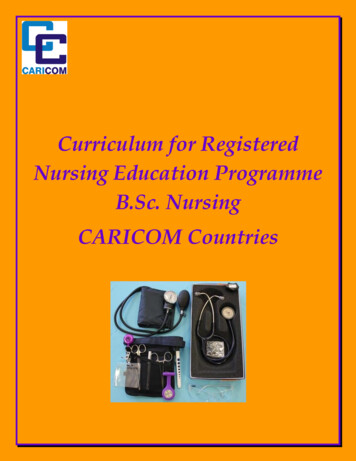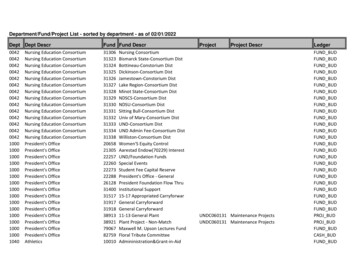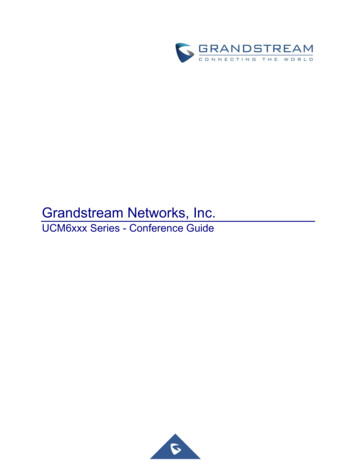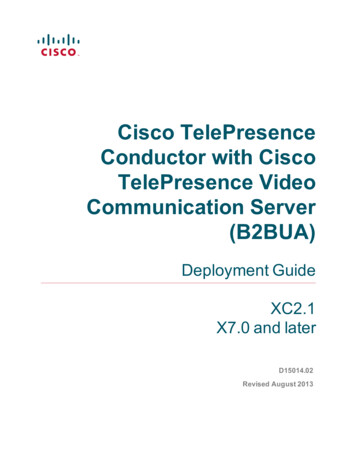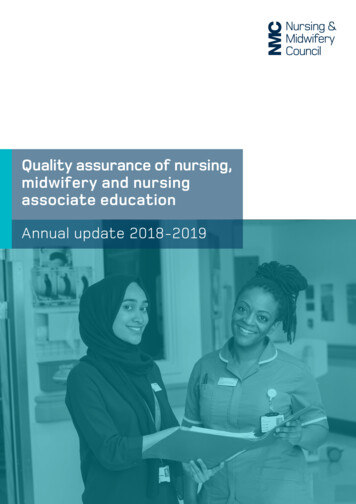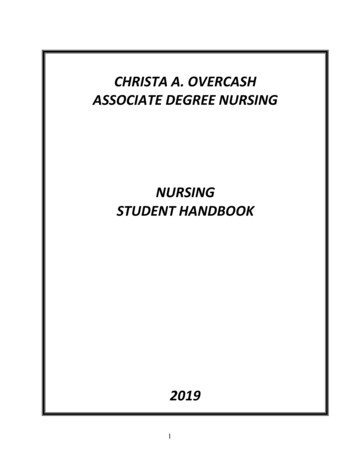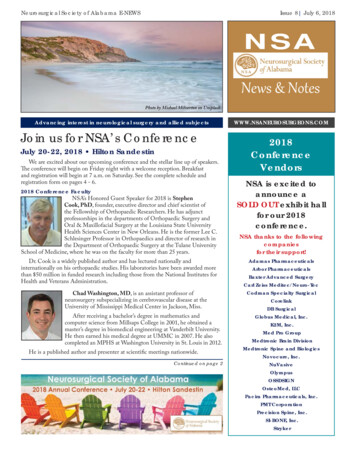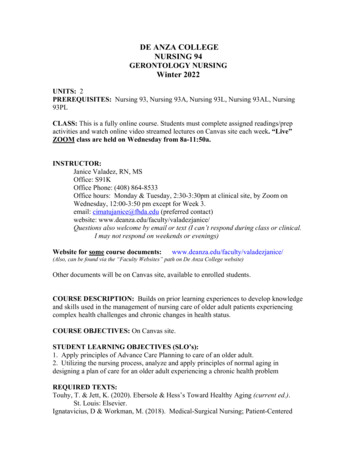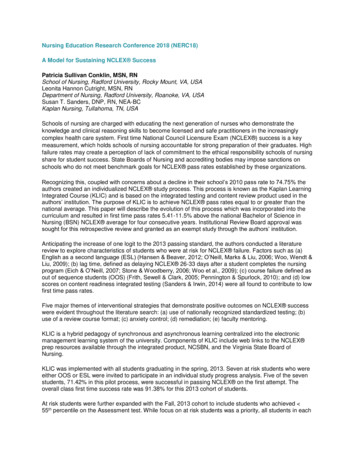
Transcription
Nursing Education Research Conference 2018 (NERC18)A Model for Sustaining NCLEX SuccessPatricia Sullivan Conklin, MSN, RNSchool of Nursing, Radford University, Rocky Mount, VA, USALeonita Hannon Cutright, MSN, RNDepartment of Nursing, Radford University, Roanoke, VA, USASusan T. Sanders, DNP, RN, NEA-BCKaplan Nursing, Tullahoma, TN, USASchools of nursing are charged with educating the next generation of nurses who demonstrate theknowledge and clinical reasoning skills to become licensed and safe practitioners in the increasinglycomplex health care system. First time National Council Licensure Exam (NCLEX ) success is a keymeasurement, which holds schools of nursing accountable for strong preparation of their graduates. Highfailure rates may create a perception of lack of commitment to the ethical responsibility schools of nursingshare for student success. State Boards of Nursing and accrediting bodies may impose sanctions onschools who do not meet benchmark goals for NCLEX pass rates established by these organizations.Recognizing this, coupled with concerns about a decline in their school’s 2010 pass rate to 74.75% theauthors created an individualized NCLEX study process. This process is known as the Kaplan LearningIntegrated Course (KLIC) and is based on the integrated testing and content review product used in theauthors’ institution. The purpose of KLIC is to achieve NCLEX pass rates equal to or greater than thenational average. This paper will describe the evolution of this process which was incorporated into thecurriculum and resulted in first time pass rates 5.41-11.5% above the national Bachelor of Science inNursing (BSN) NCLEX average for four consecutive years. Institutional Review Board approval wassought for this retrospective review and granted as an exempt study through the authors’ institution.Anticipating the increase of one logit to the 2013 passing standard, the authors conducted a literaturereview to explore characteristics of students who were at risk for NCLEX failure. Factors such as (a)English as a second language (ESL) (Hansen & Beaver, 2012; O’Neill, Marks & Liu, 2006; Woo, Wendt &Liu, 2009); (b) lag time, defined as delaying NCLEX 26-33 days after a student completes the nursingprogram (Eich & O’Neill, 2007; Stone & Woodberry, 2006; Woo et al., 2009); (c) course failure defined asout of sequence students (OOS) (Frith, Sewell & Clark, 2005; Pennington & Spurlock, 2010); and (d) lowscores on content readiness integrated testing (Sanders & Irwin, 2014) were all found to contribute to lowfirst time pass rates.Five major themes of interventional strategies that demonstrate positive outcomes on NCLEX successwere evident throughout the literature search: (a) use of nationally recognized standardized testing; (b)use of a review course format; (c) anxiety control; (d) remediation; (e) faculty mentoring.KLIC is a hybrid pedagogy of synchronous and asynchronous learning centralized into the electronicmanagement learning system of the university. Components of KLIC include web links to the NCLEX prep resources available through the integrated product, NCSBN, and the Virginia State Board ofNursing.KLIC was implemented with all students graduating in the spring, 2013. Seven at risk students who wereeither OOS or ESL were invited to participate in an individual study progress analysis. Five of the sevenstudents, 71.42% in this pilot process, were successful in passing NCLEX on the first attempt. Theoverall class first time success rate was 91.38% for this 2013 cohort of students.At risk students were further expanded with the Fall, 2013 cohort to include students who achieved 55th percentile on the Assessment test. While focus on at risk students was a priority, all students in each
cohort were provided access to individual faculty support and guidance. Cumulative pass rates reflect a95% success for all first time test-takers from the authors’ institution. Although the 5% who failed wereidentified as at risk, this only represents 8.3% of the total at risk population.Since KLIC was introduced, graduates have achieved a sustained pass rate 5.41%-11.5% greater thanthe national BSN average for four consecutive years. This preparation process incorporates the tools forstudents to provide concurrent review of the entire curriculum content and integrated threads. Thebenchmark for NCLEX pass rates established by the Program, Quality and Evaluation committee of theSchool of Nursing have been met consistently after the implementation of KLIC.More study is warranted with cohorts of varying demographics and needs. Collaboration with otherschools of nursing to replicate and validate this process has been initiated to provide greater evidence ofits effectiveness with a less homogenous group of students.Title:A Model for Sustaining NCLEX SuccessKeywords:NCLEX Candidate Empowerment, NCLEX Candidate Mentoring and Remediation StrategiesReferences:Carr, S.M. (2011). NCLEX-RN Pass rate peril: One school’s journey through curriculumrevision, standardized testing, and attitudinal change. Nursing Education Perspectives, 32(6),384-388.Carrick, J.A. (2011). Student achievement and NCLEX success: Problems that persist.Nursing Education Perspectives, 32(2), 78-83.Corrigan-Magaldi, M., Colalillo, G. & Molloy, J. (2014) Faculty-facilitated remediation:A model to transform at-risk students. Nurse Educator, 39(4), 155-157.Culleiton, A. (2009) Remediation: A closer look in an educational context. Teaching andLearning in Nursing, (4), 22-27.Eich, M. & O’Neill, T. (2007). NCLEX delay pass rate study. NCLEX Psychometric ResearchBrief. Retrieved from NCSBN. https://www.ncsbn.org/delaystudy2006.pdfFrith, K., Sewell, J., & Clark D. (2005). Best practices in NCLEX-R readiness preparation forbaccalaureate student success. Computer, Informatics, Nursing, 23(6), 322-329.Hansen, E. & Beaver, S. (2012) Faculty support for ESL nursing students: Action plan for success.
Nursing Education Perspectives, 33(4) 246-250.Hyland, J.R. (2012). Building on the evidence: Interventions promoting NCLEX success. Open Journalof Nursing.2(2012), 231-238. http://dx.doi.org/10.4236/ojn.2012.23036Irwin, B.J., Arnoldussen, B., Burckhardt, J.A., Dobish, B., Finesilver, C., Gardner,P Redemske, M. (Eds.). (2016). NCLEX-RN content review guide. (4thed). New York,NY: Kaplan, Inc.Kaplan, Inc. (2017). NCLEX Resources. Kaplan Nursing. Retrieved from https://nit.kaplan.com/homeLavin, J., & Rosario-Sim, M. (2013). Understanding the NCLEX: How to increase success onthe revised 2013 examination. Nursing Education Perspectives, 34(3), 196-198.McDowell, B. (2008). KATTS: A framework for maximizing NCLEX-RN performance.Journal of Nursing Education, 47(4) 183-186.National Council of State Boards of Nursing, (2017). Setting the NCLEX passing standards.https://www.ncsbn.org/2630.htmO’Neill, T., Marks, C., & Liu W. (2006). Assessing the impact of English as a second languagestatus on licensure examination. Retrievedfrom NCSBN. http://www.ncsbn.org/ESL Licensure.pdfPennington, T. D., & Spurlock, D. (2010). A systematic review of the effectiveness of remediationinterventions toimprove NCLEX-RN pass rates. Journal of Nursing Education, 49(9), 485492. doi:10.3928/01484834-20100630-05Sanders, S.T. & Irwin, B.J., (2014). Kaplan nursing integrated testing program faculty manual:Statistical analysis results (11th ed.). New York: KaplanStone, S., & Woodbery, P. (2006). A guide to NCLEX-RN success. NSNA Imprint, 53(1) 21.Woo, A., Wendt, A., & Liu, W. (2009). NCLEX pass rates: An investigation into the effect of lagtime and retake attempts. JONA’S Healthcare Law, Ethics, and Regulation, 11(1), 23-26.Abstract Summary:
Schools of nursing are charged with educating the next generation of nurses to become licensed and safepractitioners. This research describes the evolution of a process implemented resulting in first time passrates 5.41-11.5% above the national Bachelor of Science in Nursing (BSN) NCLEX average for fourconsecutive years.Content Outline:Introduction:Schools of nursing are charged with educating the next generation of nurses who demonstrate theknowledge and clinical reasoning skills to become licensed and safe practitioners in the increasinglycomplex health care system. First time National Council Licensure Exam (NCLEX ) success is a keymeasurement which holds schools of nursing accountable for strong preparation of their graduates. Toassist nursing students be successful on the NCLEX the authors created an individualized NCLEX study process called the Kaplan Learning Integrated Course (KLIC) and is based on the integrated testingand content review product used in the authors’ institution.Main Points:Five major themes of interventional strategies that demonstrate positive outcomes on NCLEX successwere evident throughout the literature search:A. use of nationally recognized standardizedB. use of a review course formatC. anxiety controlD. remediationE. faculty mentoringSupporting Points:A. & B. Literature shows the use of nationally recognized standardized testing and use of a review courseformat both showed merit in positively affecting NCLEX success.C. Carr (2011) shared positive results on NCLEX pass rates after incorporating a structured programthat includes a standardized testing program and the development of an NCLEX integrated clinicalconcepts course during the last semester, focusing on areas of content review, test-taking strategies andpractice as well as support for anxiety and other psychological issues.D. Pennington and Spurlock’s (2010) systematic review looked at the evidence supporting remediation asan intervention to improve NCLEX pass rates.E. Additionally, Corrigan-Magaldi, Colalillo, and Molloy (2014) in their work with a community collegeprogram found faculty mentoring to be an essential component in guiding students to NCLEX success.Conclusion:Since KLIC was introduced, graduates have achieved a sustained pass rate 5.41%-11.5% greater thanthe national BSN average for four consecutive years. Anecdotally the students reported the programprovided a mechanism to manage the testing environment. They felt empowered and confident in
utilizing both content knowledge and critical thinking, key elements of success on first time passage ofNCLEX .First Primary Presenting AuthorPrimary Presenting AuthorPatricia Sullivan Conklin, MSN, RNRadford UniversitySchool of NursingAsst. Professor of NursingRocky Mount VAUSAProfessional Experience: 2000-May 2017- Asst. Professor of Nursing; Adult Medical Surgical focusCritical Care. Radford University, Radford, Va. 2013-2017-Kaplan Learning Integrated Course (KLIC)Faculty; created concept and co-developed with Leonita Cutright, Instructor, Radford University, Radford,Va. 2006-2017-Kaplan NCLEX prep FacultyAuthor Summary: Nurse educator for 30 years. Presented at local and National conferences on criticalthinking and NCLEX preparation. NCLEX consultant for schools in Alaska, California, Tennessee andVirginia. Article accepted for publication, May 2017, in, Nursing Education Perspectives titled: A Model forSustaining NCLEX Success.Second Secondary Presenting AuthorCorresponding Secondary Presenting AuthorLeonita Hannon Cutright, MSN, RNRadford UniversityDepartment of NursingInstructorRoanoke VAUSAProfessional Experience: 1998-2016 Instructor Medical-Surgical Nursing, Radford University 2010present Kaplan Instructor for Kaplan Review course 2013 - present KLIC (Kaplan Learning IntegratedCourse) co-instructor @ Radford University 2016-present Kaplan Nurse-ExpertAuthor Summary: 18 years as a nurse educator @ Radford University 5 years as an Oncology ServiceLine Manager, Memorial Hospital, Chattanooga,Tennessee 7 years as an instructor for the Kaplan RNreview course 18 years as a member of the Carilion Medical Center IRBThird Secondary Presenting AuthorCorresponding Secondary Presenting AuthorSusan T. Sanders, DNP, RN, NEA-BCKaplan NursingVice PresidentTullahoma TNUSAProfessional Experience: 30 years of experience in nursing. Certified as a Nurse Executive withadministrative and leadership experience. Additional experience in nursing education at the teaching and
administrative level. Currently VP of Kaplan Nursing.Author Summary: Vice president of Kaplan Nursing responsible for curriculum and product developmentfor NCLEX preparation. Author, researcher, innovator, and marketing expert for the Kaplan NCLEXintegrated products.
Radford University School of Nursing Asst. Professor of Nursing Rocky Mount VA USA Professional Experience: 2000-May 2017- Asst. Professor of Nursing; Adult Medical Surgical focus Critical Care. Radford University, Radford, Va. 2013-2017-Kaplan Learning Integrated Course (KLIC)




